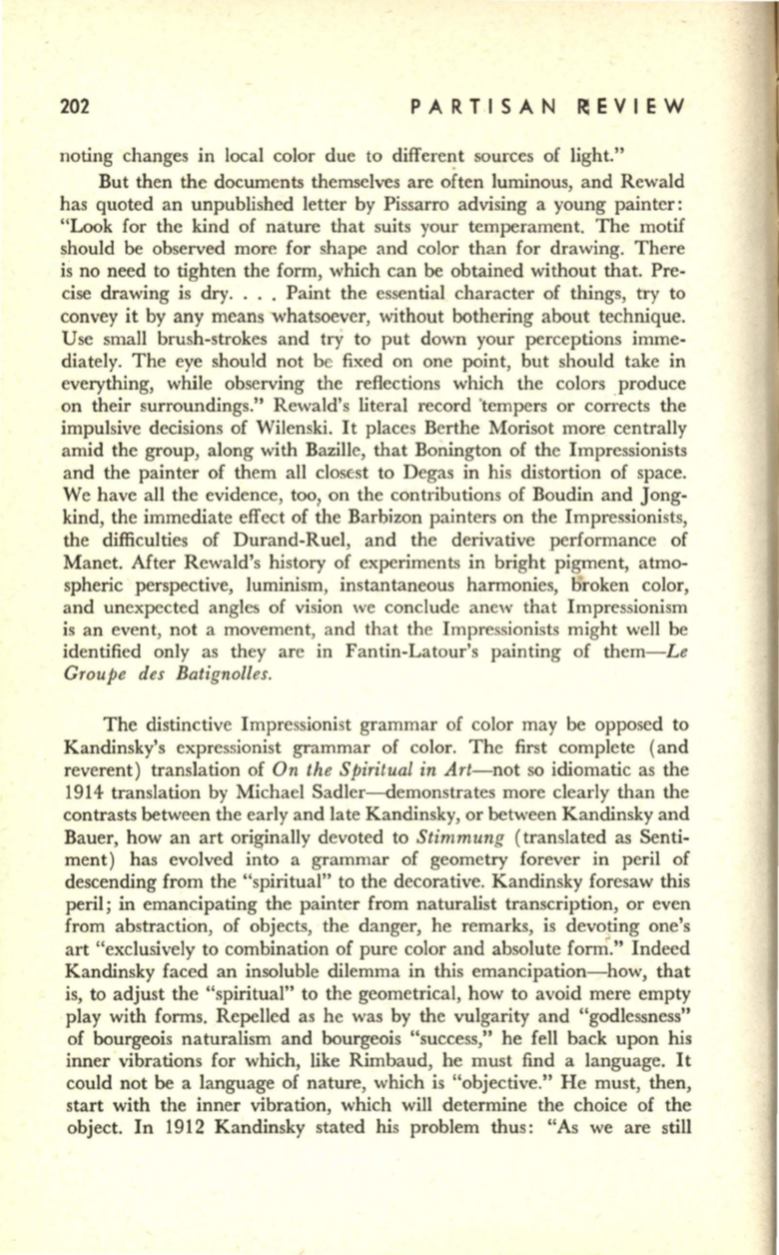
202
PARTISAN REVIEW
noting changes in local color due to
differe~t
sources of light."
But then the documents themselves are often luminous, and Rewald
has quoted an unpublished letter by Pissarro advising a young painter:
"Look for the kind of nature that suits your temperament. The motif
should be observed more for shape and color than for drawing. There
is no need to tighten the form, which can be obtained without that. Pre–
cise drawing is dry.. . . Paint the essential character of things, try to
convey it by any means whatsoever, without bothering about technique.
Use small brush-strokes and try to put down your perceptions imme–
diately. The eye should not be fixed on one point, but should take in
everything, while observing the reflections which the colors produce
on their surroundings." Rewald's literal record 'tempers or cori·ects the
impulsive decisions of Wilenski. It places Berthe Morisot more centrally
amid the group, along with Bazille, that Bonington of the Impressionists
and the painter of them all closest to Degas in his distortion of space.
We have all the evidence, too
1
on the contributions of Boudin and Jong–
kind, the immediate effect of the Barbizon painters on the Impressionists,
the difficulties of Durand-Rue], and the derivative performance of
Manet. After Rewald's history of experiments in bright pigment, atmo–
spheric perspective, luminism, instantaneous harmonies, broken color,
and unexpected angles of vision we conclude anew that Impressionism
is an event, not a movement, and that the Impressionists might well be
identified only as they are in Fantin-Latour's painting of them-Le
Groupe des Batignolles.
The distinctive Impressionist grammar of color may be opposed to
Kandinsky's expressionist grammar of color. The first complete (and
reverent) translation of
On the Spiritual in Art-not
so idiomatic as the
1914 translation by Michael Sadler-demonstrates more clearly than the
contrasts between the early and late Kandinsky, or between Kandinsky and
Bauer, how an art originally devoted to
Stimmung
(translated as Senti–
ment) has evolved into a grammar of geometry forever in peril of
descending from the "spiritual" to the decorative. Kandinsky foresaw this
peril;
in
emancipating the painter from naturalist transcription, or even
from abstraction, of objects, the danger, he remarks, is devoting one's
art "exclusively to combination of pure color and absolute forrrl'." Indeed
Kandinsky faced an insoluble dilemma in this emancipation-how, that
is, to adjust the "spiritual" to the geometrical, how to avoid mere empty
play with forms. Repelled as he was by the vulgarity and "godlessness"
of bourgeois naturalism and bourgeois "success," he fell back upon his
inner vibrations for which, like Rimbaud, he must find a language. It
could not be a language of nature, which is "objective." He must, then,
start with the inner vibration, which will determine the choice of the
object. In 1912 Kandinsky stated his problem thus: "As we are still


